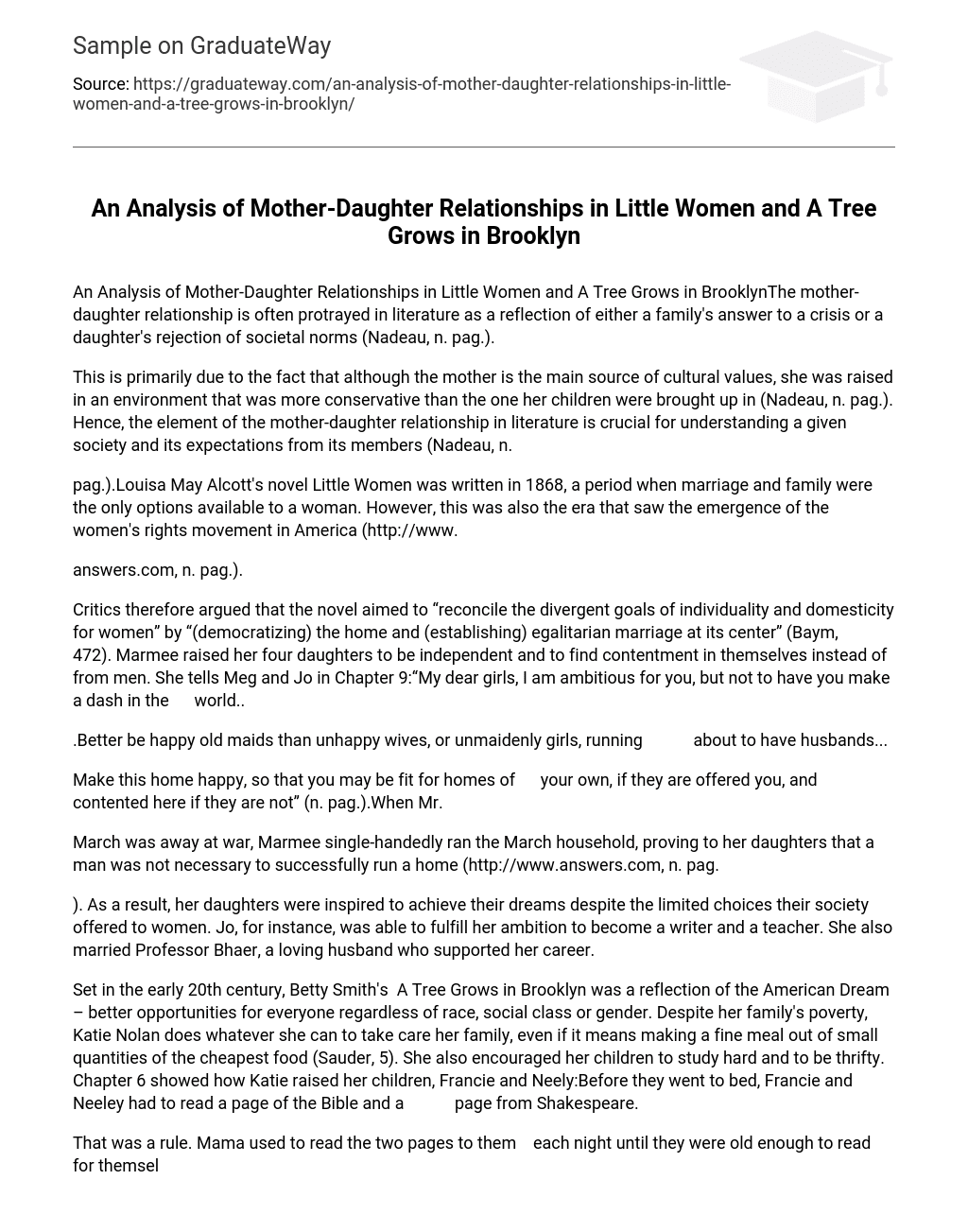An Analysis of Mother-Daughter Relationships in Little Women and A Tree Grows in BrooklynThe mother-daughter relationship is often protrayed in literature as a reflection of either a family’s answer to a crisis or a daughter’s rejection of societal norms (Nadeau, n. pag.).
This is primarily due to the fact that although the mother is the main source of cultural values, she was raised in an environment that was more conservative than the one her children were brought up in (Nadeau, n. pag.). Hence, the element of the mother-daughter relationship in literature is crucial for understanding a given society and its expectations from its members (Nadeau, n.
pag.).Louisa May Alcott’s novel Little Women was written in 1868, a period when marriage and family were the only options available to a woman. However, this was also the era that saw the emergence of the women’s rights movement in America (http://www.
answers.com, n. pag.).
Critics therefore argued that the novel aimed to “reconcile the divergent goals of individuality and domesticity for women” by “(democratizing) the home and (establishing) egalitarian marriage at its center” (Baym, 472). Marmee raised her four daughters to be independent and to find contentment in themselves instead of from men. She tells Meg and Jo in Chapter 9:“My dear girls, I am ambitious for you, but not to have you make a dash in the world..
.Better be happy old maids than unhappy wives, or unmaidenly girls, running about to have husbands…
Make this home happy, so that you may be fit for homes of your own, if they are offered you, and contented here if they are not” (n. pag.).When Mr.
March was away at war, Marmee single-handedly ran the March household, proving to her daughters that a man was not necessary to successfully run a home (http://www.answers.com, n. pag.
). As a result, her daughters were inspired to achieve their dreams despite the limited choices their society offered to women. Jo, for instance, was able to fulfill her ambition to become a writer and a teacher. She also married Professor Bhaer, a loving husband who supported her career.
Set in the early 20th century, Betty Smith’s A Tree Grows in Brooklyn was a reflection of the American Dream – better opportunities for everyone regardless of race, social class or gender. Despite her family’s poverty, Katie Nolan does whatever she can to take care her family, even if it means making a fine meal out of small quantities of the cheapest food (Sauder, 5). She also encouraged her children to study hard and to be thrifty. Chapter 6 showed how Katie raised her children, Francie and Neely:Before they went to bed, Francie and Neeley had to read a page of the Bible and a page from Shakespeare.
That was a rule. Mama used to read the two pages to them each night until they were old enough to read for themselves. To save time, Neeley read the Bible page and Francie read from Shakespeare (n. pag.
).Katie pushed her children to work hard, because she was afraid that if they “see romance in a mean life, and that without life’s cruel truths” they will not strive to imporve their lives (http://www.sparknotes.com, n.
pag.). This is most true for Francie, as, in the words of Mary, “to be born a woman is to be born into a humble life of pain” (http://www.sparknotes.
com, n. pag.).The mother-daughter relationship in Little Women had the element of empathy that the daughter achieves from the mother (staff.
wwcc.edu, n. pag.).
Marmee’s daughters grew up to be self-reliant and confident because they knew that their mother will always support them no matter what. Meanwhile, A Tree Grows in Brooklyn had the element of a daughter’s desire to be connected to her mother (staff.wwcc.edu, n.
pag.). Despite Katie and Francie’s constant fighting and Katie favoring Neely over Francie, Francie still loves her mother and takes care of her when she gave birth to her sister, Annie Laurie.The social and political environments in which the two novels were based portrayed the mother-daughter relationship as an element of change.
In Little Women, Marmee’s connection with her daughters enabled them to establish their own identities outside the bounds of society. How Katie brought up Francie in A Tree Grows in Brooklyn drove the latter to strive to lift herself and her family out of poverty. Hence, it would be fair to say that Alcott and Smith’s goal in their respective novels was to impart the message that egalitarianism began at home.Despite their differences in fashion, the mother-daughter relationships in Little Women and A Tree Grows in Brooklyn is distinctly American through its promotion of American values, such as independence, fairness, farsightedness and equality.
And by doing so, literature has once again managed to use the said kinship to analyze society and promote social change.Works CitedBaym, Nina. “A Hunger for Home: Louisa May Alcott and ‘Little Women’ by Sarah Elbert.”The New England Quarterly Vol.
57, No. 3 (1984): 472-476.“The Mother/Daughter Relationship in Young Adult Fiction.” 1995.
The Alan Review. 4February 2008 <http://scholar.lib.vt.
edu/ejournals/ALAN/winter95/Nadeau.html>.“A Tree Grows in Brooklyn by Betty Smith.” Ed.
Diane Sauder. n.p.: 1997, 1-6.
“A Tree Grows in Brooklyn (Plot Overview).” n.d. Sparknotes.
4 February 2008<http://www.sparknotes.com/lit/brooklyn/summary.html>.
“A Tree Grows in Brooklyn (Analysis of Major Characters).” n.d. Sparknotes.
4 February 2008 <http://www.sparknotes.com/lit/brooklyn/canalysis.html>.
“A Tree Grows in Brooklyn (Themes, Motifs and Symbols).” n.d. Sparknotes.
4 February 2008 <http://www.sparknotes.com/lit/brooklyn/themes.html>.
“It Takes Two (at least) to be Feminine: Three Components of Feminine Relationship.”n.d. WWCC.
edu. 5 February 2008 <staff.wwcc.edu/jon/stratton/LectFour/Hard>.
“Little Women (Historical Context).” n.d. Answers.
com. 5 February 2008<http://www.answers.com/topic/little-women-novel-5>.
“Little Women (Themes).” n.d. Answers.
com. 5 February 2008<http://www.answers.com/topic/little-women-novel-3>.





